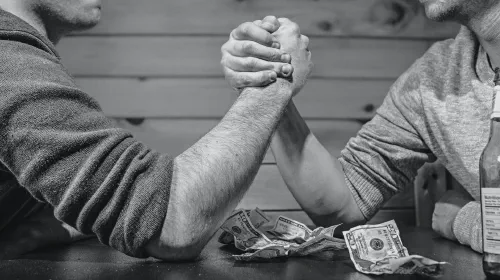What is a Social Recovery Wallet?
Salomon Kisters
Mar 29, 2023This post may contain affiliate links. If you use these links to buy something we may earn a commission. Thanks!
As digital currencies and blockchain technology continue to gain popularity, new ways of managing money are emerging, and one of them is the social recovery wallet. But what exactly is it, and how does it work differently from a regular wallet or bank account?
In a sentence, a social recovery wallet can be defined as a wallet that is recoverable even if the seed phrase is lost. While it is like a digital wallet where you can store your crypto assets securely, the difference is that it also allows you to recover access to your funds in case you forget your password or lose your private key. A social recovery wallet accomplishes this while retaining all the capabilities of a standard blockchain-based wallet and remaining non-custodial at the same time.
Let’s face it, forgetting passwords and falling victim to cyber-attacks can be a real risk when it comes to digital assets. That’s why social recovery wallets are becoming more and more popular, and in this article, we’re going to dive into the benefits and challenges they present and see how they’re changing the world of digital asset management.
Protecting Your Digital Assets with Social Recovery Wallet
Vitalik Buterin, co-founder of Ethereum in 2019, initially proposed the concept of a social recovery wallet, where he intended to overcome the problem of losing access to your wallet if you lose your seed phrase. For a decade, he obsessed with the notion of how ordinary crypto investors could safeguard themselves and their funds against potential loss or theft.
The answer he finally came up with was social recovery. Thus, he proposed the solution that the retrieval of the signing key is possible with the help of your social network.
This means that instead of relying solely on your memory, a social recovery wallet lets you choose a group of trusted people - like family members or close friends - who can help you access your funds in case of an emergency. This innovative solution gives crypto holders an extra layer of security and peace of mind.
How Does Social Recovery Wallet Work?
A crypto wallet is, at its core, a smart contract deployed on the blockchain. It has a public key, which a person can use to make all forms of transactions. In a social recovery wallet, guardians are introduced here to increase safety and security. These are trusted addresses that you add to your wallet.
If you lose access to your public key, the majority of the guardians can vote to change the key and restore your access to the wallet. You can also use your public key to change the guardians of the wallets. However, there is usually a 1-3 day delay to prevent any chances of fraudulent activity.
Since the guardian addresses are public wallets, it is not a requirement that they be held by different people. In fact, they can all be your own different wallets. However, it is suggested that you ask your friends and family to become guardians since it can be difficult for you to remember or store the seed phrases for all of your wallets in a safe place. And since, at the end of the day, all of these wallets rely on your system and your ability to maintain them, you could potentially lose all of them together.
How Big of a Problem is Wallet Security?
Even after all the measures taken to improve the security of cryptocurrency funds in general, wallet hacks are still a huge problem for investors. Hackers use various phishing techniques like fake emails and links to steal crypto from users.
There have been many instances where people lost their entire crypto holdings in seconds due to malicious attacks on crypto exchanges or individual wallets. In phishing, hackers usually send out emails containing links that, if clicked on, give the hackers access to the user’s wallet. As early as 2011, a Bitcointalk member lost 25,000 BTC after a hacker gained direct access to his computer.
Even one of the developers of Bitcoin, Stefan Thomas, lost all three backups of his wallet containing 7,000 BTC. According to statistics, 1,500 BTC are lost every day due to hacks, theft, and people generally losing access to their wallets. Over time, this loss has amounted to almost 20% of BTC’s total supply!
The Problem with Hardware Wallets
Sure, the issue with seed recovery phrases can be solved with the use of hardware wallets to some extent, but hardware wallets also encounter failures.
Since it is a physical device, a hardware wallet has to travel through a lot of channels before it reaches the end consumer. While going through the entire supply chain, it is highly possible that someone can tamper with it or replace it with a fake, and you lose your money in the blink of an eye. Even if you get a tamper-proof copy of the product, it is still a mechanical piece of equipment. Hardware can fail for any number of reasons. It can also be stolen quite easily or misplaced.
Thus, it is apparent that hardware wallets are by no means foolproof solutions, and a social recovery wallet would be a much better option when compared with hardware wallets.
How Can Multisignature Technology Help?
Multisig was considered the leading-edge technology in 2013 to tackle issues related to transaction security. It involved the use of a wallet with three keys, with at least two keys required to initiate a transaction. Initially introduced within the Bitcoin ecosystem, multisig wallets like Gnosis Safe are now available for Ethereum as well.
The success of multisig wallets by institutional investors has been noteworthy, with the Ethereum Foundation utilizing a 4-of-7 multi-sig wallet to secure its funds, along with several other organizations in the Ethereum ecosystem. However, for individuals looking to use multisig wallets, the main challenge lies in determining who holds the funds and how transactions are approved. To achieve this, a common approach is to use a combination of two easily accessible keys, such as a laptop and phone, along with a third, more secure key held offline or by a trusted friend or institution.
While this method offers reasonable security, it is not completely foolproof, as the theft of one key could potentially lead to the loss of all funds. Additionally, the usability of multisig wallets can be challenging, as transactions require the confirmation of two keys, which may not always be convenient or even possible.
Issues with Social Recovery Wallets
Sadly, it’s not all sunshine and roses in the social recovery wallet world. There are some fundamental issues with these wallets that are holding back their widespread adoption in the cryptocurrency world.
The first and most prominent issue is the complex technology that social recovery wallets use. Since multiple parties are involved in the process, a lot of approvals are required when a transaction needs to go through, which obviously wastes a lot of time and processing power.
Then there is the question of trust; if three to five trusted parties are participating in the process, to what extent can you really trust them? There is a fair chance that your guardians might collude against you. Perhaps, you may have a major argument with your friends or family, and they end up locking you out of your wallet. These things may sound far-fetched on paper but are realistic scenarios if we look at the bigger picture.
Although there are some issues with software recovery wallets, they are still the best solution we have for fixing reliability issues with crypto wallets.
Options in Social Recovery Wallets
If you want to switch to a social recovery wallet, there are some great options out there:
Argent Wallet
Argent fixes one of the biggest issues we face today, i.e. high transaction fees. It uses zkSync’s Layer 2 networks to process transactions with near-instant speed, making it a hundred times cheaper than Ethereum. You can invest and stake your crypto and earn up to 10% interest through Argent’s partners Aave, Lido, Index Coop, and Yearn. The wallet is endorsed by Vitalik Buterin, the co-founder of Ethereum, Stani Kulechov, founder and CEO of Aave, and Wouter Kampmann, Head of Engineering at MakerDAO.
ZenGo
ZenGo pitches itself as “the only self-custodial wallet with no seed phrase vulnerability”. It has a built-in Web3 firewall, a guaranteed wallet recovery model, and no seed phrase vulnerability. As a multi-chain wallet, it supports 70+ crypto assets including Bitcoin, Ethereum, and Cardano. Unlike most wallets out there, ZenGo has an added measure for security; it uses a 3D face lock and an encrypted biometric scan feature to ensure that your funds are secure.
Loopring Wallet
Loopring is another wallet that uses zkRollup Layer 2 solutions to help increase its speed and reduce transaction costs. It is an open-source, audited, and non-custodial wallet that ensures that users have complete control of their assets, and it also guarantees users Ethereum-level security. The Loopring project was initiated based on Vitalik’s post on social recovery wallets, and it aims to revolutionize the crypto wallet industry with its commitment to greater security and lower costs.
Conclusion
Social recovery wallets fix a lot of loopholes in the cryptocurrency wallet world. As smart-contract-enabled digital wallets, they allow you to get back access to your cryptocurrency even if your keys are lost or stolen.
Some people might argue that social recovery wallets go against the ideology of the blockchain by centralizing the system and also introducing third parties in the form of guardians, which defeats the very purpose of having a decentralized system.
However, the truth is that this is perhaps the best solution we have against the constant hacks and loss of funds in the blockchain ecosystem.
Public approval will clarify whether social recovery wallets become a lasting phenomenon, or whether they fade with time like so many other blockchain projects.
Stay informed with the latest insights in Crypto, Blockchain, and Cyber-Security! Subscribe to our newsletter now to receive exclusive updates, expert analyses, and current developments directly to your inbox. Don't miss the opportunity to expand your knowledge and stay up-to-date.
Love what you're reading? Subscribe for top stories in Crypto, Blockchain, and Cyber-Security. Stay informed with exclusive updates.
Please note that the Content may have been generated with the Help of AI. The editorial content of OriginStamp AG does not constitute a recommendation for investment or purchase advice. In principle, an investment can also lead to a total loss. Therefore, please seek advice before making an investment decision.

Top Saas-based Blockchain Startups
More and more startups recognize and develop use cases for blockchain beyond cryptocurrencies. Find out about the Top SAAS-based blockchain startups right now.

Polkadot vs. Solana: A Comprehensive Comparison of Strengths and Weaknesses
Learn about the strengths and weaknesses of Polkadot and Solana, two major players in the blockchain industry, to decide which is better suited for your needs.

Polygon vs. Ethereum: Key Differences Explained | SEO Blog
Learn about the key differences between Polygon and Ethereum, two prominent Proof-of-Stake networks enabling DeFi trading and NFT interactions.
Protect your documents
Your gateway to unforgeable data. Imprint the authenticity of your information with our blockchain timestamp